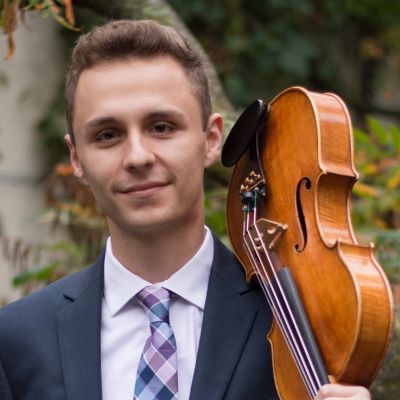
Tanner Otto
Sycamore Community Schools
Cincinnati, Ohio
Tanner Otto admits to being a thief. “Most of my ideas have been ‘borrowed’ from other orchestra teachers,” he says. The idea for the marching orchestra came from his teacher, Brian Cole, whose middle school orchestra played and walked in the fall homecoming parade for years. “As a student I always enjoyed the experience of being in a parade and throwing out candy to those who came to watch. The homecoming parade at Sycamore Community Schools is one of my favorite events of the year. Most people expect to see the marching band in the parade, but seeing the orchestra is a fun surprise! The parade is a great way for us to be visible in the community and for our students to show their school spirit.”
The orchestra director adds that violins and violas walk the parade while cellos and basses sit on a flatbed trailer or in the back of a pickup — see the video of the marching orchestra in action.
Another “borrowed” idea was a concert that featured a glow-in-the-dark rendition of “Twinkle Twinkle Little Star.” Otto says, “We started by putting glow-in-the-dark stars on the instruments, then we took it to the next level by buying glow bracelets for each student in our school colors. In the moments before we played ‘Twinkle Twinkle,’ students cracked their bracelets and put them on their bow hands. Once the lights were off, it created a super cool look. I even used a giant glow stick as a baton!”
These out-of-the-box ideas make orchestra fun and engaging for his students. He supplements the method book for his second-year students with pop songs or music from movies or TV shows. “Students love to play music they recognize, and many of them have pedagogical merit,” Otto explains. “For example, ‘Havana’ by Camila Cabello is great for refining the C major finger pattern and off-beat 8th notes. ‘The Star Spangled Banner’ is perfect for forward extensions. Many of these songs can be arranged into different keys, depending on what students are working on.”
Otto adds improvisation, composition and digital music creation into the curriculum. He says, “While improv is something we work on all year, composing and music creation are great units to do after concerts or before breaks. Students really enjoy these projects and I love seeing how creative their final products are.”
Another unique teaching method Otto uses is to have students work with partners to refine their technique. “Working with a peer is less intimidating and makes orchestra more social,” he says. “I find it especially useful when we begin working with the bow. In no time, students begin acting as the teacher, recognizing mistakes and helping their partner.”
Even his classroom setup is forward thinking. “Even before COVID, we sat in a grid with a few feet between each chair,” Otto explains. “Having space between each student really helps with classroom management and gives me the ability to walk around the room and get to every student. I also don’t have a podium or stand at the front of the room and that keeps me from being tied to one spot. I often walk around with my instrument so that I can play along or demonstrate.”








